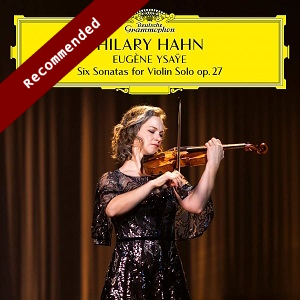
Eugène Ysaÿe (1858-1931)
Six sonatas for solo violin, Op 27 (1923-4)
Hilary Hahn (violin)
rec. 2022, Fraser Performance Studio, GBH Educational Foundation, Boston, USA
Deutsche Grammophon 4864176 [64]
I have admired Hilary Hahn ever since she made a success of recording Schoenberg’s notoriously thorny Violin Concerto (review). So, when the opportunity came to review this set of Ysaÿe solo sonatas, works which I had often heard of but never heard, I jumped at it.
Ysaÿe was inspired to write these sonatas by hearing a performance of the Bach solo sonatas and partitas by Joseph Szigeti. His own performing career was coming to an end and he wanted, among other things, to encourage the coming generation of violinists. Consequently, each of the sonatas is dedicated to one of them, and sometimes makes reference to their individual playing styles. He was influenced by Bach, as of course he had to be in writing for this medium, but he also wanted to include technical challenges, perhaps thinking here of Paganini’s caprices, and also to evoke current, or at least recent, composing styles. He had premiered the Franck violin sonata and also the Chausson Poème, and I fancy I hear something of Franck’s idiom in several of these pieces.
The first sonata, appropriately dedicated to Szigeti, is the closest to Bach’s sonatas in its formal structure. It is also the longest of the set. The first movement is slow with multiple stops on the violin, but the idiom is more chromatic than Bach. Ysaÿe also uses the whole tone scale and has a passage sul ponticello, sounding somewhat eerie, towards the end. The second movement is a fugue, a very Bachian choice, the third graceful and elegant and the finale strong and passionate.
The second sonata, dedicated to Jacques Thibaud, opens with an actual quotation from Bach’s E major partita but also weaves into the texture the Dies irae, which he draws on in all four movements, each of which has a name. The first is Obsession, the second Malincolia, in which the violin is muted, the third is Musette and features a drone and the finale, Les Furies, has something of Gluck’s dance of the furies about it.
The third sonata is dedicated to George Enescu and is a single movement with many changes of tempo. Ysaÿe was perhaps thinking of Enescu’s early Rumanian Rhapsodies, his best-known though not his most characteristic works. Again, we have the whole tone scale and writing which becomes increasingly flamboyant, reflecting Enescu’s personality as a player.
The fourth sonata is in three movements and is dedicated to Fritz Kreisler. Kreisler had the odd habit of writing pastiche compositions and attributing them to minor or non-existent eighteenth century composers. This sonata begins with an Allemande and continues with a Sarabande. The finale, however, is an exciting perpetuum mobile.
The fifth sonata is dedicated to Mathieu Crickboom, who was second violinist of the Ysaÿe Quartet. It is in two movements. The first is called L’Aurore, dawn, and the booklet suggests it recalls Debussy or Ravel. The second movement is called Danse rustique and to me it sounds like early Bartók.
The final sonata is dedicated to Manuel Quiroga, a Spanish violinist who was compared to Sarasate. After preliminary flourishes, this settles down to a habañera and concludes with violinistic fireworks.
In a charming piece included in the booklet, Hilary Hahn explains that she had the idea of recording the sonatas earlier this year, because it was the centenary year of the sonatas, or at least of the sketches of most of them. At the time, she had not played them for at least ten years. Nevertheless, she managed to find time in her schedule and recorded them over a period of seven weeks. While doing so she felt she was really in touch with the spirit of Ysaÿe, and felt this was confirmed when she heard some of his own playing from the earliest days of recording.
I haven’t heard Ysaÿe’s own recordings but I cannot praise these performances enough. They are wholly gripping and absorbing; they sound as if Hahn was improvising these pieces and yet they have been thoroughly prepared. The virtuosity, which is very considerable, sounds, as it should, both natural and challenging at the same time. Her tone is lustrous and gleaming, her intonation perfect and her grasp of the idiom secure.
The recording is very atmospheric, perhaps slightly close but a touch on the controls deals with that. The booklet contains, as well as Hahn’s own piece, a valuable essay by Robert Kirzinger, on which I have drawn for this review. This recording has already drawn enthusiastic praises in many places and I am happy to add my own to them.
Stephen Barber
Help us financially by purchasing from




















